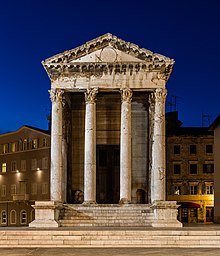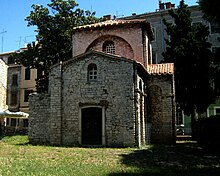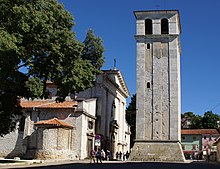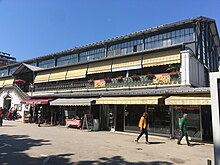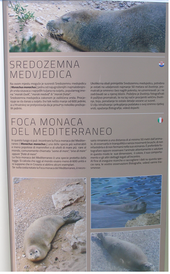Pula
|
Pula Pola |
|||
|
|||
|
|
|||
| Basic data | |||
|---|---|---|---|
| State : |
|
||
| County : |
|
||
| Height : | 0 m. i. J. | ||
| Area : | 70 km² | ||
| Residents : | 57,460 (2011) | ||
| Population density : | 821 inhabitants per km² | ||
| Telephone code : | (+385) 052 | ||
| Postal code : | 52 100 | ||
| License plate : | PU | ||
| Boat registration : | PU | ||
| Structure and administration (status: 2013, cf. ) |
|||
| Community type : | city | ||
| Structure : | 16 districts | ||
| Mayor : | Boris Miletić ( IDS / DDI ) | ||
| Coalition partner : | HNS, Zeleni | ||
| Postal address : | Forum 1 52 100 Pula |
||
| Website : | |||
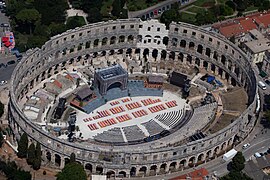 The amphitheater of Pula , symbol of the city |
|||
Pula [ ˈpuːla ] ( German and Italian Pola ; Slovenian Pulj ; ancient Greek Πόλαι Pólai ; Latin Colonia Pietas Iulia Pola Pollentia Herculanea ) is the largest city in the Istria County in Croatia with 57,460 inhabitants (as of 2011) . Pula is located near the southern tip of the Istrian peninsula and belongs to the Catholic diocese of Poreč-Pula .
history
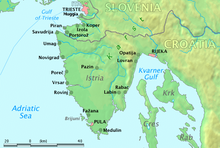
Antiquity
In the vicinity of Pula, prehistoric pottery from the Neolithic Age (6000–2000 BC) was found, which indicates an early settlement. The first settlement of the city by the Illyrian tribe of the Histri is dated to the 10th century BC.
Conquered by Romans in 177 BC, Pula became a Roman colony under the name Colonia Pietas Iulia Pola . Under Emperor Augustus was amphitheater built, which is one of the main attractions of the city today. In addition to the amphitheater, there is the temple of Roma and Augustus from the Augustinian period , the partially preserved city wall with gates and the remains of two theaters.
In the 4th century AD, a naval base for the Venetian fleet ( classis Venetum ) was established there to protect the Adriatic coastal waters .
When the Western Roman Empire collapsed in the 5th century, Pula came under the rule of the Ostrogoths. Emperor Justinian was able to conquer Pula for the Eastern Roman Empire in the 6th century; the city was expanded to become a naval base for the Byzantines.
In the second half of the 6th century the Slavs invaded Istria. The Istrian coastal cities, including Pula, could not be captured. There the urban culture of the long-established novels continued seamlessly.
While the Istrian hinterland was part of the Frankish Empire from the end of the 8th century and later the Holy Roman Empire , Pula nominally remained part of the Byzantine Empire, but was in fact independent.
Venetian rule
With the decline of Byzantine power, Pula had to look for new allies. The Republic of Venice took the place of the Byzantine emperor at the end of the 11th century . In 1150, Pola signed a treaty with the lagoon city through which the city submitted to the rule of the Venetians. Since then people have paid tribute, participated in the construction and equipping of galleys for the Venetian fleet and dispatched troops when the Republic of St. Mark was at war.
The Counts of Gorizia exercised considerable influence in the 13th century and appointed the vicarius in Istria. The Sergi family succeeded in gaining the support of the Patriarch of Aquileia in addition to the Görzern and thus established an almost independent rule from around 1294, which lasted until 1319. In 1331 the city council offered submission to Venice, in 1335 the inhabitants destroyed the castle and the tower over the city to prevent the Sergi from returning. Later a Venetian nobleman was appointed head of the city administration. Pula remained part of this state until the end of the Republic of Venice in 1797, after which it became part of the Habsburg rule, since 1804 called the Austrian Empire .
Austrian rule
After the revolution of 1848, Venice was no longer a port for the Austrian Navy as a main port of war ; the crews of the ships in the arsenal had almost always joined the uprising directed against Austria. There was a choice between expanding Trieste , which already had an efficient commercial port, or the small fishing town of Pola, which at that time only had about 900 inhabitants, but an almost perfect natural harbor. Naval commander Hans Birch Dahlerup initially favored Trieste due to the existing infrastructure, but was soon convinced of the advantages of a completely new beginning in Pola, which was also much easier to defend.
Emperor Franz Joseph I knew the Pola Bay from a visit in 1845 (still as Archduke) and visited it again in 1850; he should have personally played an important role in the decision in favor of Pola. In 1851 the Pola municipal council ceded four large plots of land free of charge to the military for the construction of a new marine arsenal. In 1852, for the first time, there were comprehensive plans for the expansion to become the main Austrian naval port.
On December 9, 1856, Emperor Franz Joseph I officially laid the foundation stone for the construction of the Sea Arsenal; he was accompanied by his wife Elisabeth and his brother, the naval commander Archduke Ferdinand Max , who was promoted here by the emperor to vice admiral. At this point in time, the construction of the Seearsenal was already well advanced. (The Uljanik shipyard in Pula still refers to the official founding date of December 9, 1856.)
In the following years Pula experienced a boom, which was almost exclusively due to the expansion into the Austrian main war port: the population of the city grew from 900 in 1848 to 6551 in 1857, to 25,179 in 1881 and finally 58,560 in the last census among Austrian Rule in 1910. All major buildings (shipyard, naval barracks, machine school, naval hospital, naval garrison church, naval casino, hydrographic office with observatory, infantry barracks, train station, social housing, civil schools, hotels, etc.) were directly connected to the expansion of the k. u. k. Main port of war and still shape the entire cityscape today. In astronomy Pula is by Johann Palisa known of at the local Naval Observatory from 1874 to 1880, the first 29 of his 123 asteroids discovered.
In Meyer's Konversations-Lexikon in 1896 one and a half printed pages were dedicated to the city: Pola was described as a fortress of the first order; On the hills above the city there were 28 forts , some with armored turrets. The outer harbor was located between the island of Brioni / Brijuni and the mainland; the actual port was 8.6 km², partly a trading port, partly a naval port. The marine section of the k. u. k. Ministry of War operated in Pola from dry and floating docks to the naval academy, the hydrographic office , an artillery laboratory and a powder magazine to the arsenal (with 2000 workers) all important facilities for naval warfare. Along with the monarchy 's submarines, the submarines of the Mediterranean submarine of the German Imperial Navy were also stationed here during the First World War . Even today, the “K. u. k. Naval Cemetery “on Ulica Stoja (Via Stoia) and the facilities in the bay next to it at this time.
Around 1912 in the k. u. k. Naval port Pola built the first large radio telegraph station - Radiopola - with a long range to the Atlantic and the Red Sea.
Since the First World War
When the new South Slavic state was formed at the end of the First World War on October 29, 1918 and Austria-Hungary lost its access to the sea as a result, Emperor Charles I ordered the k. u. k. Handing over the navy to the southern Slavs. On October 31, 1918 Rear Admiral Horthy made the surrender in Pola as ordered: The k. u. k. The war flag was lowered, the South Slavic flag was raised, and South Slav naval officers took command.
Nevertheless, the battleship Viribus Unitis , which was now called Jugoslavia and was still the pride of the fleet, was sunk on November 1, 1918 at 6 a.m. by two Italian combat swimmers who had distributed and detonated explosives on the hull using a converted torpedo. Over 400 sailors died, including the last in command of the ship, Janko Vuković-Podkapelski ; In his honor and that of the other fallen, a memorial plaque was placed in Pola.
After the armistice of November 3, 1918, Pola was occupied by Italian troops until November 9, which also took over the fleet. Through the Treaty of Saint-Germain and other peace treaties in 1919, like all of Istria , Italy became part of it .
At the end of the Second World War , the city was captured by Yugoslav troops in May 1945, but they had to leave by June 12, 1945 at the latest. The USA, Great Britain and Yugoslavia had agreed on June 9, 1945 that the city, like the area of and around Trieste , would be administered jointly by the war victorious. Pula here formed a Exklave the (Italian) Zone A in the (Yugoslav) Zone B .
In 1947, however, the city was not incorporated into the Free Territory of Trieste , which was constituted as a separate state , but was added to the Yugoslav republic of Croatia , as determined in the Italian-Yugoslav part of the Paris Peace Treaty of 1947 .
A large part of the Italian population group, about 30,000 out of 34,000, then left the city for Italy.
The Vergarola massacre contributed to this . On August 18, 1946, during the festival of an Italian sports club in a pine forest near the beach in Vergarola Bay near Pola, already defused mines with nine tons of explosives exploded. The explosion was blamed on the Yugoslav secret service OZNA and officially claimed 65 lives, but probably significantly more.
Like all of Croatia, Pula was part of Yugoslavia until 1991 . The island of Brioni off Pula (as it was quoted in foreign media) or Brijuni gained international fame because the Yugoslav head of state Marshal Tito set up his summer residence there, where he was visited by statesmen from all over the world. In addition, the Brioni Agreement was concluded on the islands in 1991 , which ended the 10-day war in Slovenia .
population
The city had about 1,100 inhabitants in 1851, around 25,000 in 1880 and almost 39,000 in 1890, including 5900 members of the military. According to the k. k. In the 1900 census, 40,641 people including the garrison lived in Pula, of whom 24,056 were Italians (59%), 10,388 Croats (26%), 4,654 Germans (11%) and 1,543 Slovenes (4%).
According to the 2011 census, Croatians make up the vast majority of the population, accounting for 70.14% of the population. 29.86% belong to other ethnic groups, of which the Serbs with 6.01% and the Italians with 4.43% are the two largest in Pula. In addition, Slovenes, Bosniaks, Albanians, Hungarians, Germans, Sinti and Roma live in Pula. The Jewish community today has 30 to 50 members.
The city of Pula is officially bilingual. In addition to Croatian , Italian is the second official language. The Istrian language , the oldest language in Istria , is spoken in the hinterland .
religion
After many Orthodox Serbs left Pula, the religious majority undoubtedly belong to the Catholic residents of Pula, while the Orthodox believers form the second largest group. Protestants and Muslims represent each other with single-digit percentages.
The Byzantine Chapel of St. Mara Formosa (kapelica sv. Marije Formose) was built in the 6th century. A basilica of the same name that was added at the time was destroyed in the 16th century. The architectural design of the chapel is based on the image of a Greek cross and shows parallels to churches in Ravenna.
Church of St. Francis with Franciscan monastery (Samostan i crkva sv. Franje). The single-nave, late Romanesque church goes back to a building in the 13th century; It is mentioned in 1314. The Franciscan monastery was built in the 14th century and shows Roman influence in the cloister in some places in the artistic decoration.
The Cathedral of the Assumption of the Virgin Mary (Katedrala Uznesenja Blažene Djevice Marije) was built from the 6th century, with the remains of walls from earlier church buildings have been found. The expansion continued into the 10th century, but later there was serious destruction and devastation, which was attributed to the Genoese and subsequently to the Venetians. An extensive reconstruction then takes place in the 15th century. The addition of a facade in the late Renaissance style in the 16th century gave the cathedral its current appearance. From 1671 a free-standing bell tower was built in front of the church.
The Orthodox Church of St. Nicholas (Pravoslavna crkva sv. Nikole) also dates back to the 6th century. It has a polygonal apse and was expanded in the 10th century. The church has some icons from the 15th and 16th centuries, as well as an iconostasis from the 18th century.
Attractions
One of the main attractions and at the same time the symbol of the city is the amphitheater , which was built under Emperor Augustus and expanded under Emperor Vespasian . It has a size of 133 meters × 105 meters, offered about 23,000 people, making it one of the largest amphitheaters built by the Romans. The facade, which has been preserved in large parts up to the original height of 32.5 meters, is also Augustinian according to more recent views.
Another well-preserved Roman monument is the Arch of the Sergians , which was built between 29 and 27 BC in memory of Octavian's victory in the Battle of Actium . Also worth seeing are the Augustus temple (2 BC to 14 AD) and the Archaeological Museum of Istria (AMI) with the double gate Porta Gemina as access to the main building of the museum.
The town of Markt Pula is right in the center, not far from the Arch of the Sergians. The market hall, a former train station built in 1903, the market square with agricultural products and countless cafés and restaurants with local and international cuisine.
traffic
railroad

On September 20, 1876, Pula was connected to the Austrian Southern Railway ( Vienna - Trieste ) by the "Istrian State Railway" with a branch line . This branch line, the Divača – Pula line , is still the only railway connection between the port city and the hinterland.
Street
Pula forms the southern end point of the Istrian Ypsilon of the A 8 ( Rijeka ) and A 9 ( Umag ) motorways . Pula has an international airport ( IATA code : PUY , ICAO code : LDPL ).
Shipping
Pula is a port city . During the k. u. k. At that time, Pula was the monarchy's most important naval port. It is no coincidence that the k. u. k. Marine established the world's first maritime museum in Pula. After the Second World War, the port increasingly lost its importance as a military base. The Brionian Islands in front of the port entrance form the Fasana Canal with the mainland and have long served as the outer port. The actual port has an extension of 5.5 km and extends from the southeast to the northeast, has an area of 8.5 km² and contains four small islands. One of them, the Olive Island, houses part of the shipyard (dry dock and floating dock) of the local Uljanik shipyard . The port is the starting point for several ferry connections as well as the speedboat traffic with Venice and other Istrian port cities such as Rijeka (it. Fiume). From a tourist point of view, the new marina in the Veruda district is becoming more and more important compared to the old fishing and industrial port.
tourism
From five kilometers northwest of the city center is the Brijuni National Park , which consists of fourteen islands and belongs to the urban area. Pula is the end point of the EuroVelo 9 cycle route , which runs from Gdansk on the Baltic Sea through Poland , the Czech Republic , Austria , Slovenia and Croatia .
The beaches of the Verudela district, which lies on a foothill in the Adriatic Sea, are among the few in the whole of the Mediterranean where the rare monk seals can be observed again and again . A female who has returned since 2014 and shows little fear of people has achieved a certain media popularity and was baptized with the name Adriana .
Culture and sport
The Pula Film Festival has been held annually since 1954.
In the city there is a large sports hall Dom sportova Mate Parlov , in which the clubs ŽRK Arena, MRK Arena, OK Pula, BK Pula, HK Istarski borac, STK Pula, KK Uljanik and others play. The football clubs NK Istra 1961 and NK Istra Pula are based in Pula.
sons and daughters of the town
- Antonio Smareglia (1854–1929), Italian composer
- Franz Karl Ginzkey (1871–1963), Austrian officer, poet and writer
- Max Edler von Poosch (1872–1968), Austrian portrait and landscape painter
- Emilie von Hallavanya (1874–1960), Austrian painter
- Hede von Trapp (1877–1947), Austrian painter
- Harry Heusser (1886–1943), Austrian marine painter and graphic artist
- Karl Albrecht von Habsburg-Lothringen (1888–1951), Austrian and Polish military, landowner and candidate for the Polish throne from 1916
- Herman Potočnik (1892–1929), Austrian-Slovenian officer and space theorist
- Leo Karl von Habsburg-Lothringen (1893–1939), Austrian and Polish military
- Hans Sidonius Becker (1895–1948), Austrian author, painter and resistance fighter
- Wilhelm Franz von Habsburg-Lothringen (1895–1948), Habsburg candidate for the throne for a Ukrainian satellite state during the First World War
- Irene Schaschl-Schuster (1895–1979), Austrian craftsperson
- Harry Hardt (1899–1980), stage, film and television actor
- Francesco Zagar (1900–1976), Italian astronomer
- Harald Leithe-Jasper (1904–1977), German diplomat during the National Socialist era
- Friedrich Wilhelm Cavallar von Grabensprung (1904–1989), old Austrian engineer, inventor, officer and motor vehicle expert
- Antonio Vojak (1904–1975), Italian football player and coach
- Wolf von Aichelburg (1912–1994), Transylvanian-German writer
- Wilhelm Ehm (1918–2009), Deputy Minister for National Defense in the Council of Ministers of the GDR and head of the People's Navy
- Alida Valli (1921-2006), Italian actress
- Rossana Rossanda (* 1924), Italian intellectual and writer
- Eugenio Ravignani (1932–2020), Italian clergyman, Bishop of Trieste
- Sergio Endrigo (1933–2005), Italian singer and songwriter
- Laura Antonelli (1941–2015), Italian actress
- Alka Vuica (* 1961), songwriter and singer
- Tamara Obrovac (* 1962), jazz singer and composer
- Toni Cetinski (* 1969), musician, singer and presenter
- Massimo Demarin (* 1979), racing cyclist
- Jadranka Đokić (* 1981), actress
- Stiven Rivic (* 1985), football player
- Stjepan Hauser (* 1986), cellist (2Cellos)
- Marijan Perković (* 1989), racing cyclist
- Tereza Mrdeža (* 1990), tennis player
- Valentino Stepčić (* 1990), football player
- Marko Buvinić (* 1992), handball player
- David Barišić (born 1997), football player
Twin cities
Pula lists the following eight partner cities :
| city | country | since |
|---|---|---|
|
|
|
1974 |
|
|
|
1972 |
|
|
|
2007 |
|
|
|
1973 |
|
|
|
2012 |
|
|
|
1971, September 8th |
|
|
|
1980 |
|
|
|
2008 |
There are also partnerships with:
Climate table
|
Average monthly temperatures for Pula
Source: wetterkontor.de
|
|||||||||||||||||||||||||||||||||||||||||||||||||||||||||||||||||||||||||||||||||||||||||||||||||||||||||||||||||||||||||||||||||||||||||||||||||||||||||||||||||||||
See also
literature
- Wilhelm M. Donko: Pola / Pula - A historical travel guide through the former main war port of Austria-Hungary in Istria (Croatia). Berlin 2015, ISBN 978-3-7375-2418-6 .
- Günter Fischer: The Roman Pola. An archaeological city history. (= Treatises of the Bavarian Academy of Sciences / Philosophical-Historical Class, NF; Volume 110). Bavarian Academy of Sciences, Munich 1996, ISBN 3-7696-0105-X
- Hans-Dieter and Elke Kaspar: Istria - an archaeological journey of discovery. Schonungen 2005, ISBN 3-925696-18-0 .
Web links
Individual evidence
- ↑ Pula in Numbers, 2011 Census , pula.hr Accessed on December 13, 2019
- ^ Hans DL Viereck: The Roman fleet, Classis Romana. Köhlers Verlagsgesellschaft mbH, Hamburg 1996, ISBN 3-930656-33-7 , pp. 257-258.
- ↑ Wilhelm M. Donko: Pola / Pula - A historical travel guide through the former main war port of Austria-Hungary in Istria (Croatia). Verlag epubli, Berlin 2015, pp. 35–42.
- ↑ 5th edition. 13th volume, Bibliographisches Institut, Leipzig and Vienna 1896, p. 1032 f.
- ↑ The relics of the kuk radio: Military infrastructure for civil purposes , orf.at, June 15, 2017, accessed on June 15, 2017.
- ^ Anthony Eugene Sokol: Sea power Austria. The Imperial and Royal Navy 1382–1918. Fritz Molden Verlag, Vienna 1972, ISBN 3-217-00472-8 , p. 195.
- ^ Agreement for the Provisional Administration of Venezia Giulia, June 9, 1945 , Articles 1, 3, 4 and 6.
- ↑ Ralf Wörsdörfer: Hotspot Adria 1915–1955 , Schöningh, Paderborn 2004, p. 543 ff.
- ^ Karl-Peter Schwarz: The first hour of remembrance in the Bay of Vergarola. In: Frankfurter Allgemeine Zeitung . August 23, 2008.
- ↑ KK Statistische Central-Commission, Special-Orts-Repertorien of the kingdoms and countries represented in the Oesterreichischen Reichsrathe. Volume VII. Coastal Land, Vienna 1883, p. 82.
- ↑ A travel report by Alexander Bollinger , https://deinreisemagazin.de , June 10, 2020, accessed on June 10, 2020.
- ↑ Trade, Industry, Transport and Agriculture. (…) Railway buildings in 1876. In: Wiener Zeitung , October 5, 1877, p. 7, top left. (Online at ANNO ).
- ^ Main port of war of the Austro-Hungarian monarchy. deutsche-schutzgebiete.de. Retrieved April 20, 2016 .
- ↑ Website of the marina. Marina info. Retrieved April 20, 2016 .
- ↑ Mediterranean monk seal a regular guest on the beaches in Pula / Pola. PulaInfo. Retrieved April 29, 2014 .
- ↑ Gradovi pobratimi. Retrieved February 2, 2018 .
- ↑ Comune di Verona - Grandi Eventi - Gemellaggi e Patti d'Amicizia . Retrieved May 3, 2018.



